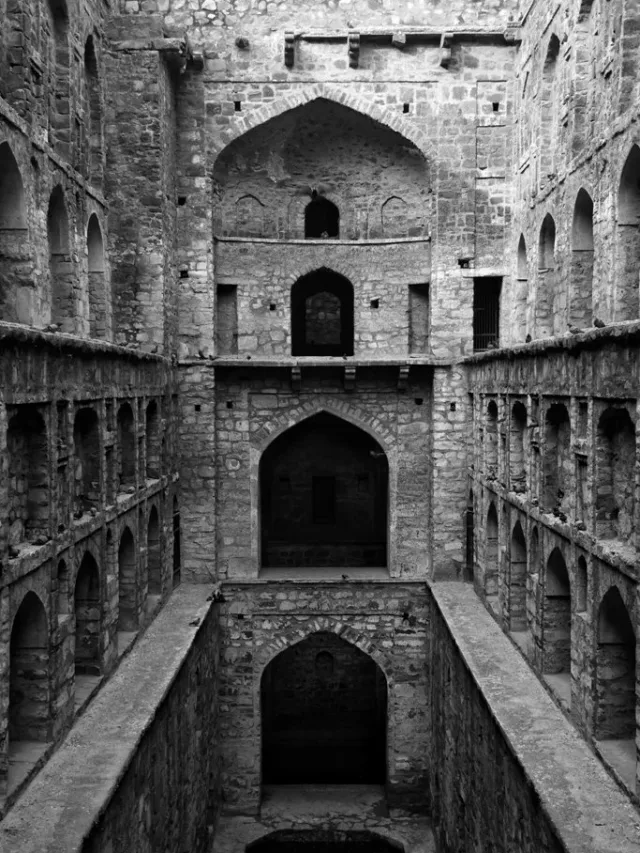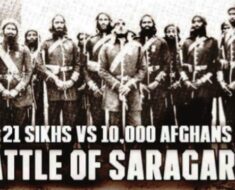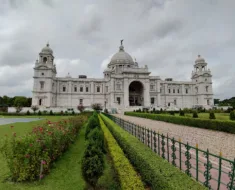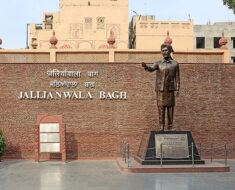Rajasthan the ‘Land of Kings’ is one of the most popular holiday destinations in India. It is a land of vibrant colours, heritage and cultural excellence. The beautiful state of Rajasthan has magnificent historical monuments and places that narrate the tales of valour, romance, and grandeur.
Here’s a list of the most famous historical places in Rajasthan you must explore on your next trip
- Amber Fort
- City Palace
- Jaigarh Fort
- Chittorgarh Fort
- Jaisalmer Fort
- Mehrangarh Fort
- Umaid Bhawan Palace
- Kumbhalgarh Fort
- Jantar Mantar
- Hawa Mahal
- Jal Mahal
- Nahargarh Fort
- Junagarh Fort
- Ranthambore Fort
- Chand Baori
1. Amber Fort
Set amidst the hills and overlooking the Maota Lake, the magnificent Amber Fort also known as Amer Fort is one of the top tourist attractions of Jaipur. The Amber Fort is an extensive palace complex that has been built with pale yellow and pink sandstone, and with white marble.

The Amber Fort was constructed by Raja Man Singh in 1592 AD and later expanded and renovated by Raja Jai Singh I. The Fort is a great example of Rajput architecture and some of its structures and works have Mughal architecture influence.
The fort is laid out on four levels, each having a courtyard. The palace complex has many structures like the Diwan-e-Aam, the Diwan-e-Khas, the Palace of Man Singh I, the Sila Devi temple, the Sheesh Mahal, the Sukh Mahal, the Tripolia Gate, and the Lion Gate.
The Amer Fort is a UNESCO World Heritage Site, along with five other forts of Rajasthan as a part of the group Hill Forts of Rajasthan. These include Chittor Fort at Chittorgarh, Kumbhalgarh Fort at Rajsamand, Ranthambore Fort at Sawai Madhopur, Gagron Fort at Jhalawar, Amer Fort at Jaipur and Jaisalmer Fort at Jaisalmer.
2. City Palace
The City Palace in Udaipur is an iconic symbol of Rajasthan’s royal heritage, situated on the bank of Lake Pichola and it is one of the top tourist destinations in Udaipur and a major historical place in Rajasthan
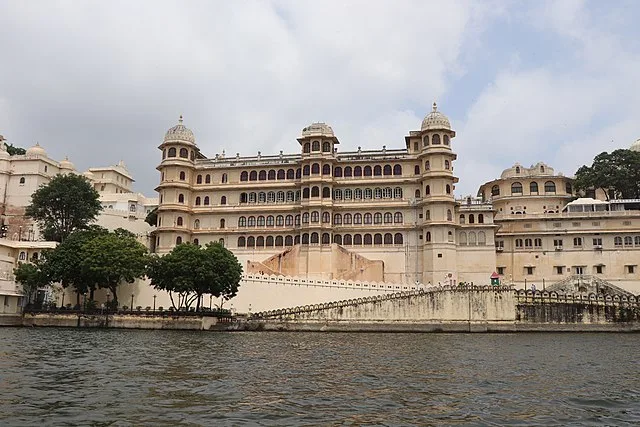
A perfect fusion of Rajputana and Mughal architecture, it was constructed by Maharana Uday Singh in the year 1559. Spread across an area of 5 acres it is a complex of several palaces and is the largest palace in Rajasthan.
Construction of the palace was started in 1599 under Maharana Udai Singh II, the city’s founder, and was and continued for over 400 years under his successors. The palace is surrounded by fortifications and is made of granite and marble. It has massive gates known as “pols”, with Bara Pol being the main gate and also has a triple-arched gate called Tripolia.
Nestled in the Aravali mountain range and overlooking Lake Pichola the palace complex has several historic monuments like the Lake Palace, Jag Mandir, Jagdish Temple, Monsoon Palace, and Neemach Mata temple.
A large part of the City Palace was turned into a museum, known as the City Palace Museum in 1974.
Read More: 15 Must-Visit Historical Places in India
3. Jaigarh Fort
Jaigarh Fort is located on the Cheel ka Teela of the Aravalli range overlooking the Amer Fort and is one of the most famous historical places in Rajasthan.
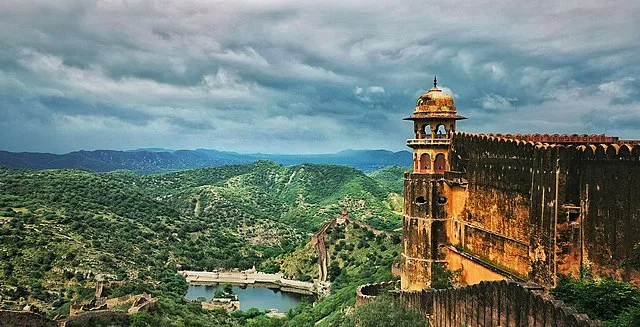
The fort was built by Mirza Raja Jai Singh in 1726 to protect the Amer Fort and its palace complex. The fort offers panoramic views of the surrounding area and has a length of 3 km along the north-south direction and a width of 1 kilometre
It is also known as Victory Fort and houses the world’s largest cannon on wheels called “Jaivana Cannon”. Jaigarh Fort and Amer Fort are connected by underground passages and are considered as one complex.
There is a watch tower in the fort that provides views of the surrounding landscape. The fort has two temples, the Ram Harihar temple of the 10th century and the Kal Bhairav temple of the 12th century.
4. Chittorgarh Fort
Chittorgarh Fort is a UNESCO World Heritage Site and one of India’s largest forts spread over an area of 691.9 acres. The fort holds significant historical, and cultural importance and is a testament to the valour and resilience of the Rajput warriors.

It is believed to be built in the 7th century AD by the Mauryans, the fort gets its name from the Mauryan ruler, Chitrangda Mori. Chittorgarh Fort is one of the most visited historical places in Rajasthan.
The fort complex has 65 historic structures including 4 palaces, 19 temples, 4 memorials and several water bodies. The fort is surrounded by massive walls and is famous for its seven gates namely Padan Gate, Ganesh Gate, Hanuman Gate, Bhairon Gate, Jodla Gate, Lakshman Gate and the main gate named after Lord Ram.
The Chittorgarh Fort houses many palaces, like the Rana Kumbha Palace, the Fateh Prakash Palace, the Vijay Stambh, Kirti Stambh, Rani Padmini’s Palace and many historic temples like Kalika Mata Temple, Meerabai Temple, Sammidheshwara Temple, Neelkanth Mahadev Temple and Kumbha Shyam Temple within the fort.
This large fort complex is roughly shaped like a fish when viewed from a bird’s eye view.
Read More: Statue of Unity – Tallest Statue in the World
5. Jaisalmer Fort
Jaisalmer Fort perched atop Trikuta Hill offers stunning views of Jaisalmer city and is one of the famous historical places in Rajasthan.

The fort is a 250-foot-tall structure and is also known as the Golden Fort or Sonar Qila. It was built by the Rajput ruler Rawal Jaisal in 1156 AD and was reinforced by subsequent rulers of Jaisalmer.
The fort is made of yellow sandstone, which gives it a golden hue and is considered one of the oldest continuously inhabited forts in the world. It’s also one of the few “living forts” in the world, with about a quarter of the old city’s population still living within its walls.
The fort is a complex that includes temples, shops, and houses. Its walls are about 30 meters high and are fortified with bastions. The fort has four fortified entrances, one of which was previously guarded by a cannon.
Read More: Top 10 Best Places to Visit in Jaisalmer
6. Mehrangarh Fort
The magnificent Mehrangarh Fort is one of the largest forts in India and a major historical monument in Jodhpur, Rajasthan. Standing tall on a cliff called Bahuchiriya, the fort is spread across an area of 1200 acres.
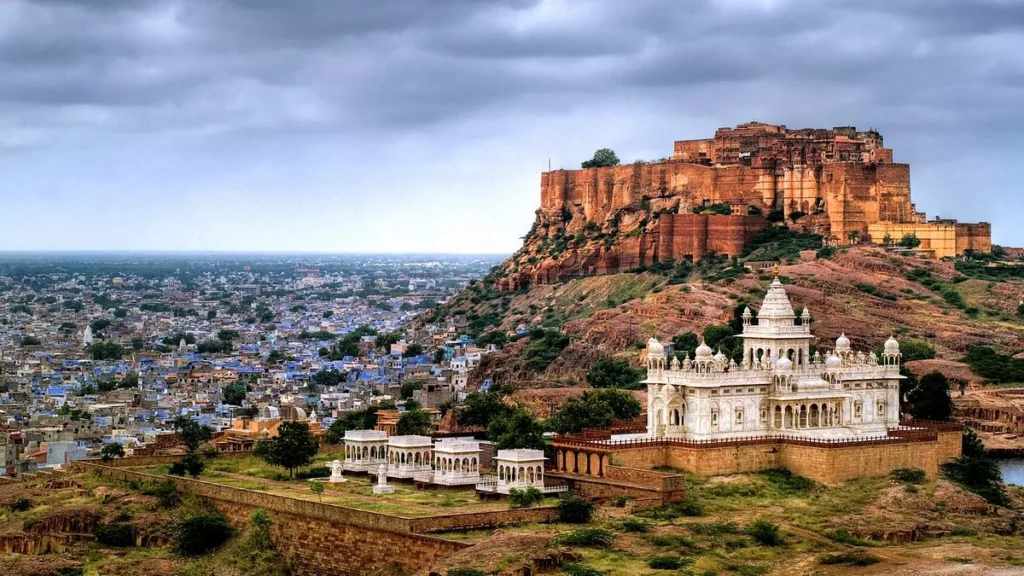
The 15th-century royal fort was constructed by Rathore King Rao Jodha. The fort’s walls are over 500 yards long, 70 feet thick, and in some places reach a height of 120 feet. The fort’s structure was built over five centuries, from the mid-15th century to the late 20th century.
There are seven gates, which include Jai Pol (meaning ‘victory gate’), built by Maharaja Man Singh to commemorate his victories over the Jaipur and Bikaner armies in 1806. The Fattehpol (also meaning ‘victory gate’), commemorates the victory of Maharaja Ajit Singh over the Mughals.
The main palaces located in the Mehrangarh Fort are Moti Mahal, Phool Mahal, Sheesh Mahal, Zenana Dude, Takht Vilas and Jhanki Mahal. There are also two temples located inside the fort – Chamundi Devi Mandir and Nagnechiaji Mandir, dedicated to Goddess Durga and the Kuldevi respectively.
There is also a museum within the Mehrangarh Fort, which exhibits a rich collection of palanquins, musical instruments, royal cradles, costumes, arms, furniture and paintings.
7. Umaid Bhawan Palace
An architectural marvel, Umaid Bhawan Palace is a spectacular heritage building in Jodhpur, the Blue City in Rajasthan. The grand palace is a testament to the luxurious lifestyle of the royal family of Jodhpur.
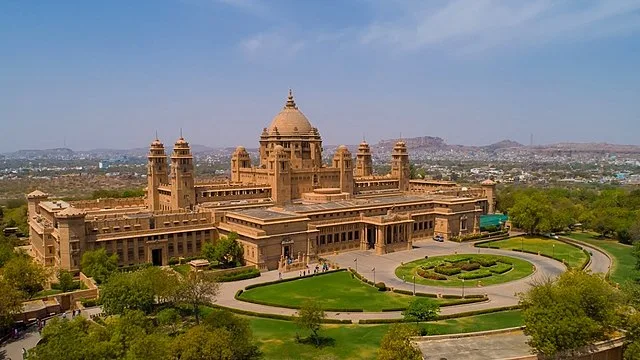
The palace is nestled atop Chittar Hill and is also known as Chittar Palace Jodhpur. It’s one of the largest private residences in the world. The palace has 347 rooms, a museum, a vintage car collection and a part of the palace houses a lavish five-star heritage hotel managed by the Taj Hotels.
The grand palace was built between 1929 and 1943 under the patronage of Maharaja Umaid Singh. It was designed by the famous British architect Henry Lanchester.
Jodhpur faced severe drought and famine in the 1920s for three consecutive years. The farmers of the area were faced with this hardship and asked for help from Maharaja Umaid Singh. To help the farmers, he decided to build a lavish palace and about 2,000 to 3,000 people were employed in its construction
Read More: Taj Mahal – The Symbol of Love
8. Kumbhalgarh Fort
The majestic Kumbhalgarh Fort is located in the foothills of the Aravalli Mountain Range about 48 km from Rajsamand city. The fort is known for its 38-kilometre wall, the second longest in the world after the Great Wall of China.
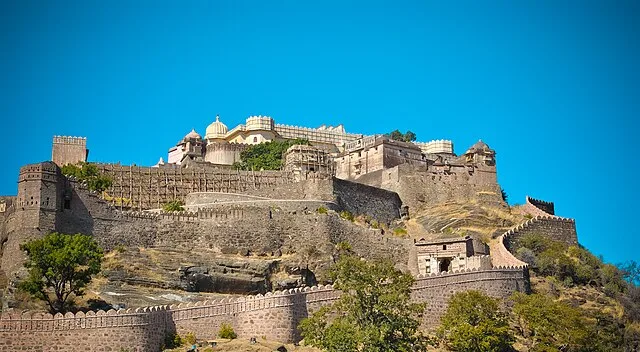
Also known as the Mewar Fortress it was built by Mewar King Rana Kumbha in the 15th century and is recognised as a UNESCO World Heritage Site. The fort is the birthplace of Maharana Pratap, a great Rajput king.
The front walls of the fort are 4.5 m, and it has seven fortified gateways. There are over 360 Hindu and Jain temples within the fort, indicating the religious tolerance of the rulers and how they patronized the Jains, encouraging their culture in the kingdom.
9. Jantar Mantar
Jantar Mantar is believed to be one of the oldest astronomical observatories in the world. Located in the heart of Jaipur city is a collection of 19 astronomical instruments.

It is the largest of the five astronomical observatories built by Maharaja Sawai Jai Singh II and is one of the most famous historical places in Rajasthan.
The name Jantar Mantar is derived from the Sanskrit words Yantra, meaning “instrument or machine”, and mantrana meaning “consult, calculate.” Thus, Jantar Mantar means ‘calculating instrument’.
A UNESCO World Heritage Site, Jantar Mantar houses the world’s largest stone sundial known as the Samrat Yantra and other stone assemblies that help to observe and interpret the position of celestial bodies and calculate local time.
Read More: 10 Magnificent Royal Palaces In India You Must Visit
10. Hawa Mahal
Hawa Mahal is an iconic landmark of Jaipur and is one of the most popular tourist attractions of Jaipur city. It was built by Maharaja Sawai Pratap Singh in 1799 and literally means the “Palace of the Winds”.

Maharaja Sawai Pratap Singh built the palace for the ladies of the royal family to witness the grandeur of the city from the Jharokhas without being seen themselves. The palace has 953 windows, which are called ‘Jharokhas’
The Hawa Mahal is an architectural marvel and blend of the Rajput and Mughal architectural styles. Designed by Lal Chand Ustad, the five-storey Hawa Mahal is the tallest building in the world, built without a foundation.
Maharaja Sawai Pratap Singh was a devotee of Lord Krishna and dedicated the palace to him. It is said that the shape of the building resembles the crown of Krishna.
11. Jal Mahal
Jal Mahal or the water palace stands in the middle of the Man Sagar Lake in Jaipur. The magnificent five-story palace is a famous historical tourist attraction in Rajasthan.
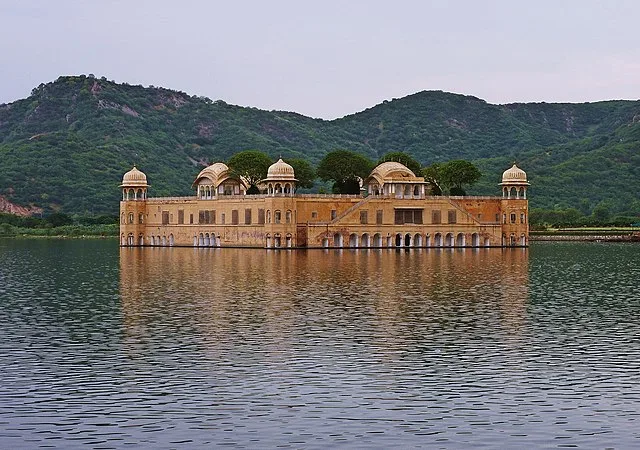
The palace is made of red sandstone and is influenced by both Rajput and Mughal architecture. It was built by Maharaja Madho Singh I and it was supposed to be a hunting lodge for the Maharajas. The palace was later renovated and enlarged by Maharaja Jai Singh II of Amber.
The palace is not open to visitors, but you can see it by taking a boat ride on the lake.
Read More: Neermahal – The Largest Water Palace in India
12. Nahargarh Fort
Nahargarh Fort is located on a ridge of the Aravalli Hills and offers stunning views of the Pink City of Jaipur. The fort was a hunting and retreat place for the Maharajas of Jaipur.
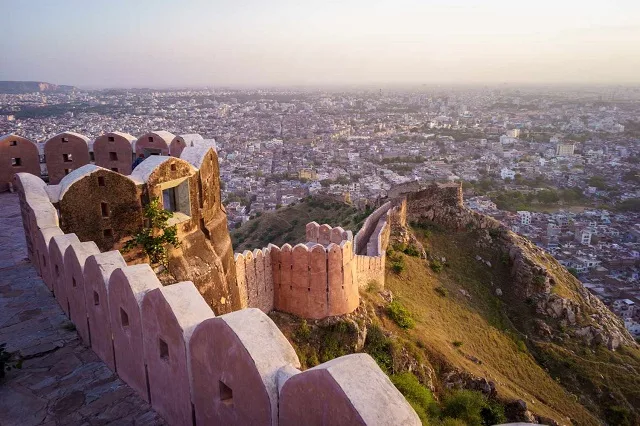
The fort was originally named Sudarshangarh but was later renamed Nahargarh which means ‘Abode of Tigers’. It was part of a defence ring for Jaipur, along with Amber and Jaigarh Forts.
The fort was built by Maharaja Sawai Jai Singh in 1734 and was designed in the Indo-European architectural style. The fort has many structures and temples inside its complex.
There is a temple inside the fort dedicated to the Rathore Prince Nahar Singh Bhomia. Some of the other prominent structures include Jaipur’s first wax museum, Madhavendra Bhawan and the Sheesh Mahal which displays 25 million glass pieces with intricate designs and gold polishing.
13. Junagarh Fort
Junagarh Fort is a well-preserved and decorated fort in Bikaner and it depicts the grand lifestyle of the Maharajas of Bikaner. It is one of the few major forts in Rajasthan which is not built on a hilltop and the modern city of Bikaner is developed around it.
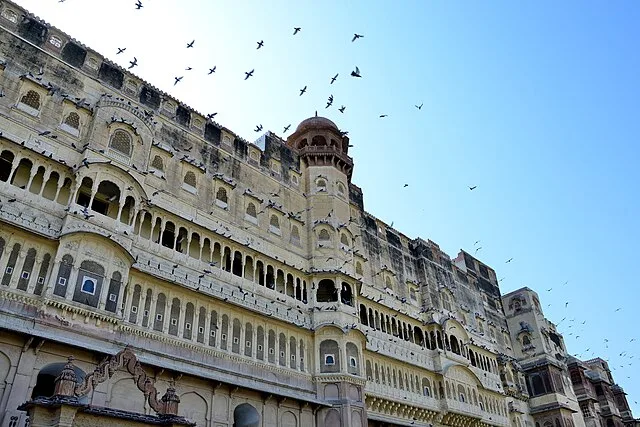
The structure of Junagarh Fort is made of red sandstone and marble. The stunning fort is one of the major historical places in Rajasthan. The fort complex was built under the supervision of Karan Chand, the Prime Minister of Raja Rai Singh, the sixth ruler of Bikaner, who ruled from 1571 to 1611 AD.
There are many beautiful palaces within the Junagarh Fort like the Badal Mahal Palace, the Gaj Mandir Palace, the Phool Mahal Palace, the Anup Mahal Palace, the Hawa Mahal Palace and the Vikram Vilas Palace.
In 1961 a museum was established by Maharaja Dr Karni Singhji that exhibits many Persian and Sanskrit manuscripts, royal costumes, jewels, farmans, howdahs and war drums.
Read More: 10 Most Famous Historic Forts in India
14. Ranthambore Fort
Ranthambore Fort is located within the Ranthambore National Park in Sawai Madhopur and is one of the major historical places in Rajasthan. The national park around the fort used to be the hunting grounds of the Maharajahs of Jaipur until the Independence of India.

The Fort provides a panoramic view of the surrounding Ranthambore National Park and is a UNESCO World Heritage Site under the group Hill Forts of Rajasthan. The fort was built in 944 AD by the Chauhan rulers and has witnessed many sieges and battles.
The most famous war was between Rao Hamir and the Muslim invader Alauddin Khilji in 1301. During this war, the Royal women performed “Jauhar“.
The fort is protected by a large wall with seven gates for entry and exit. There are many structures like Toran Dwar, Mahadeo Chhatri and Sametonki Haveli and also temples dedicated to Ganesha, Shiva and Ramlalaji constructed in the 12th and 13th centuries within its premises.
15. Chand Baori
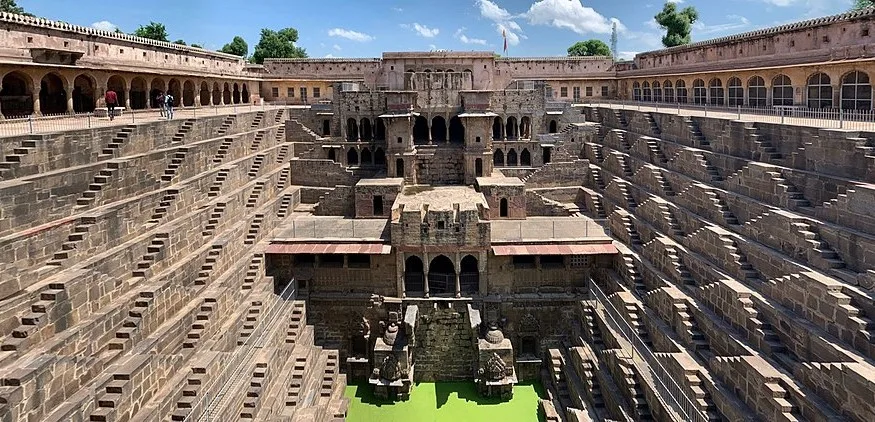
The Chand Baori is a 1,200-year-old stepwell in the village of Abhaneri, Rajasthan. It is one of the largest and deepest stepwells in India. The stepwell has 13 levels and extends 100 feet (30 meters) into the ground. Located 88km from Jaipur is one of the most popular attractions in Rajasthan.
It is an architectural wonder with 3,500 perfectly symmetrical, narrow steps and was built by King Chanda of the Nikumbha Dynasty in the 9th century AD. Near the baori there is Harshat Mata temple, the goddess of joy and happiness
Chand Baori was constructed to conserve water and provide relief from the intense heat of Rajasthan. It was also a community gathering place for locals as well as royals.



